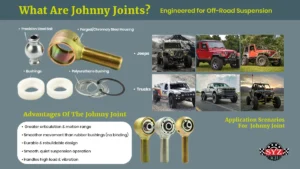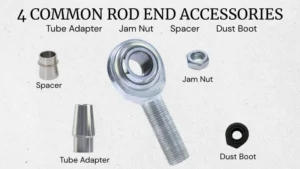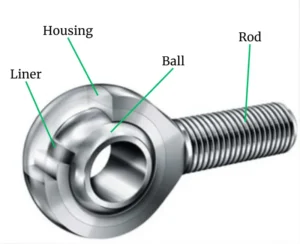Smart mechanical components may not make headlines like self-driving cars or AI chatbots, but they could change the way machines work just as much. From electric vehicles to drones to autonomous transport systems, these machines are smarter than ever—processing data, making split-second decisions, and optimizing performance in real time.
Yet the mechanical parts inside them—bearings, joints, linkages—remain largely the same as they were decades ago. Industry experts point out that even specialized parts, such as those produced by a heim joints manufacturer, have mostly evolved through incremental changes: lighter materials, stronger coatings, and more efficient production. The next big leap could be components that actively monitor their own condition and share data instantly. Imagine a rod end that reports load, wear, and stress levels without a mechanic ever touching it. This quiet revolution could make machines safer, longer-lasting, and far easier to maintain—transforming industries from transportation to manufacturing.
Why Small Upgrades Aren’t Enough Anymore?
For decades, the evolution of mechanical components has been a story of steady, incremental progress. Manufacturers have worked hard to make parts lighter, stronger, and more resistant to wear. New alloys, improved surface treatments, and advanced machining methods have all played a part in boosting performance and lowering production costs.
Better Materials, Same Role
Take bearings, joints, and linkages as an example. Even with modern coatings that fight corrosion and friction, their fundamental role hasn’t changed—they still perform a single, mechanical function. A rod end is designed to handle angular misalignment in a system; whether it’s made from carbon steel, stainless steel, or a high-performance composite, it’s still essentially the same component. This is why many industry insiders see the current generation of parts as “optimized,” but not “reimagined.”
Incremental Gains Can’t Keep Up
The challenge is that the machines these components serve are evolving far faster than the parts themselves. Smart mechanical components, when they do appear, tend to be limited to certain sectors or high-value equipment. Meanwhile, the rest of the industry is still relying on parts that simply don’t provide feedback. Imagine running an autonomous vehicle or an automated production line without any insight into the health of its critical joints—maintenance becomes a guessing game, and downtime remains a costly risk.
The Innovation Gap
This gap between mechanical capability and digital intelligence is what many engineers believe will define the next wave of industrial innovation. Embedded sensor joint components, real-time data monitoring mechanical parts, and adaptive mechanical components are no longer futuristic concepts; they are already being tested in related fields like aerospace bearings and predictive maintenance components for heavy machinery. The real question is how quickly these ideas can move into mainstream manufacturing.
What’s Already Out There in Smart Components?
While the idea of smart mechanical components might feel like a leap into the future, a closer look shows that pieces of the puzzle are already here. Across various industries, engineers have been experimenting with ways to make mechanical parts more intelligent—not by replacing their core function, but by giving them the ability to sense and communicate.
Smart Bearings Leading the Way
One of the most notable examples is the smart bearing. Companies like igus and SKF have developed bearings with embedded sensors that monitor temperature, vibration, and load in real time. These readings can be transmitted to a maintenance system, allowing engineers to detect early signs of wear before a failure occurs. In heavy industry and rail transport, this has already proven to reduce unplanned downtime and extend component life.
IoT-Enabled Components in Niche Applications
In aerospace and high-end industrial automation, there are examples of sensor-integrated linkages and joints designed for predictive maintenance. These embedded sensor joint components feed data into IoT platforms, enabling technicians to schedule part replacements based on actual usage rather than fixed intervals. This is where real-time data monitoring mechanical parts start to deliver measurable ROI.
Rod Ends: A Future Candidate for Smart Integration
Rod ends—also known as heim joints—have yet to see large-scale adoption of built-in sensors, but their role in critical systems makes them a prime candidate. They already handle high loads, angular misalignment, and harsh environmental conditions in applications ranging from motorsports to industrial equipment. Industry analysts point out that manufacturers with deep expertise in custom rod ends could be well-positioned to adapt these components for smart integration in the future.
What these examples show is that the technology exists—it’s just unevenly distributed. Bearings may be leading the charge, but there’s no reason components like rod ends, linkages, and other mechanical joints couldn’t follow the same path once the right cost-benefit balance is achieved.
Imagine a Part That Can Talk Back
Picture this: you’re running an automated production line or operating a piece of heavy equipment in the field. Every part is doing its job, but one component—a joint, a linkage, a bearing—suddenly sends you a notification. It tells you that it’s reaching its load limit, or that a certain section is wearing faster than expected. You don’t need to stop the machine to check; the part has effectively “spoken” to you through data.
This is the core promise of truly smart mechanical components. By embedding miniature sensors, wireless transmitters, and even small-scale processors directly into the part, it becomes more than a piece of metal. It becomes a data source. These embedded sensor joint components can measure load, vibration, temperature, and other stress factors, sending that information to a central system in real time.
In high-value industries like aerospace, precision manufacturing, and defense, this kind of capability can be transformative. A data-enabled rod end in a satellite deployment mechanism could alert ground control before a critical tolerance is exceeded. A sensor-equipped linkage in a robotic assembly line could signal the need for a swap before it slows production.
While these systems aren’t yet commonplace, the groundwork is already being laid. Suppliers with advanced machining capabilities and experience in custom part design are in a strong position to make the leap when demand rises. For instance, a custom vehicle parts manufacturer that already builds precision components for demanding applications could adapt those skills to produce sensor-ready designs.
If bearings are the first step toward intelligent hardware, parts like rod ends and linkages could be the next wave. The hardware is ready; the question is how quickly industries will embrace the idea that a mechanical part doesn’t just work—it can also talk.
When Smart Parts Are Worth the Money?
Not every machine needs a component that can collect and transmit data. In fact, for many applications, the economics simply don’t work out. The technology for smart mechanical components may be available, but whether it makes sense to use it depends on the value of the equipment, the cost of downtime, and the safety implications.
Why Cost Matters?
Embedding sensors, processors, and communication modules into a part isn’t free. There’s the initial development cost—designing the housing, ensuring durability under harsh conditions, and integrating electronics without compromising mechanical strength. Then there’s the usage cost: data management systems, periodic calibration, and potential sensor replacement. For low-cost equipment, such as a consumer-grade off-road vehicle or basic agricultural machinery, these expenses can outweigh the benefits. If a standard rod end fails, it’s cheaper and faster to simply replace it than to monitor it in real time.
Where the ROI is Strong?
In contrast, high-value and high-risk applications tell a different story. In aerospace, a single component failure can cost millions and compromise safety. In precision automation, unexpected downtime can halt an entire production line, resulting in major revenue loss. In military systems, predictive maintenance can mean the difference between mission success and failure. For these sectors, predictive maintenance components and real-time data monitoring mechanical parts can provide a measurable return on investment.
The Middle Ground
There’s also a middle category: industries where downtime is costly, but the equipment isn’t extremely high-value. Here, selective use of embedded sensor joint components on the most critical points could be a smart compromise—balancing cost against the benefits of early fault detection.
The takeaway is clear: the decision to adopt smart parts isn’t just about what’s technically possible. It’s about where they provide the most value, and that means matching the right technology to the right application.
The Tech Roadblocks We Have to Solve
Even when the cost makes sense, bringing smart mechanical components into the real world isn’t as simple as dropping a sensor into a piece of metal. There are major technical challenges that have to be addressed before these parts can become mainstream.
Durability Under Extreme Conditions
Mechanical components often live in environments that electronics hate—high heat, constant vibration, moisture, and even chemical exposure. A rod end on a piece of mining equipment might work reliably for years in harsh conditions, but embed a circuit board inside it, and you’re suddenly dealing with issues of sealing, insulation, and shock resistance. Designing embedded sensor joint components that can survive in these conditions requires careful material selection, advanced sealing techniques, and extensive testing.
Powering the Intelligence
Sensors and transmitters need energy to work. In stationary systems, a wired connection might be possible, but in most applications, parts are moving, rotating, or inaccessible. That means finding ways to power them without bulky batteries that need frequent replacement. Some research points to energy harvesting—using vibration, heat, or motion to generate electricity—as a potential solution, but scaling that to mass production remains a challenge.
Data Transmission and Security
Real-time data monitoring mechanical parts are only useful if the information reaches the right place at the right time. Wireless communication in industrial environments can be tricky—metal structures, interference, and long distances can disrupt signals. On top of that, transmitting performance data over networks raises cybersecurity questions. For high-value sectors like aerospace or defense, secure and encrypted transmission is not optional—it’s mandatory.
Balancing Complexity with Maintainability
Finally, the smarter a part gets, the more there is to maintain. Predictive maintenance components are supposed to reduce downtime, but if the sensors themselves need constant calibration or fail prematurely, they can become a new point of failure. Achieving reliability without overcomplicating maintenance routines is a balancing act that designers will need to master.
In short, the road to truly intelligent mechanical components runs through some difficult engineering terrain. But for industries where uptime, safety, and performance are critical, solving these problems will be worth the effort.
How We Could Get There?
Bringing smart mechanical components from concept to common use will take more than just better technology—it will require collaboration across engineering, manufacturing, and data science. The goal isn’t to reinvent every part, but to selectively make the components that matter most smarter, without overcomplicating the systems they serve.
Start with Critical Components
Not every part in a machine needs to be intelligent. The first step is to focus on the components that have the biggest impact on performance and downtime. These could be key load-bearing joints in heavy equipment, precision linkages in automated production lines, or high-stress rod ends in aerospace systems. By targeting the highest-value points, manufacturers can prove the ROI before scaling the concept further.
Integrate with Existing Platforms
The real power of embedded sensor joint components comes when they work seamlessly with existing industrial IoT (IIoT) platforms. If a smart rod end can send real-time load and wear data directly into the same dashboard that manages the rest of a plant’s equipment, adoption becomes far more appealing. Compatibility reduces the learning curve and leverages the data infrastructure companies already have.
Design for Maintainability
Predictive maintenance components are supposed to reduce headaches, not add new ones. That means designing them so that sensors, batteries (if used), and other electronics can be easily replaced or serviced without removing the entire component from the machine. Modular designs, where the “smart” portion can be swapped independently, could be key to widespread adoption.
Build Industry Confidence
For industries like aerospace, defense, or medical manufacturing, new technology has to prove itself before it’s trusted. That means extensive testing, certification, and real-world trials. Pilot programs—where smart mechanical components are installed on a limited number of machines and monitored over time—can provide the hard data needed to win over cautious buyers.
So, Are We Ready?
Smart mechanical components represent more than just an engineering upgrade—they’re a chance to close the gap between the physical and digital worlds in machinery. The technology exists in pockets today, and the benefits are clear for high-value, high-risk applications. The challenge is balancing cost, reliability, and ease of integration so that these innovations can move from niche use to everyday reality.
For any forward-thinking heim joints manufacturer, the opportunity is obvious: the skills and experience gained from producing precision, high-performance parts today can be the foundation for building the intelligent components of tomorrow. Whether the leap happens in two years or ten, one thing is certain—mechanical parts won’t stay silent forever. Sooner or later, they’ll start talking back.






